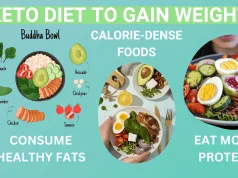How to low carb diet – How to start a low-carb diet can seem daunting, but it doesn’t have to be. This dietary approach, focused on reducing carbohydrate intake while emphasizing protein and healthy fats, has gained popularity for its potential benefits, including weight loss and improved blood sugar control. By understanding the principles of a low-carb diet and making gradual changes, you can embark on a journey toward a healthier lifestyle.
This guide delves into the fundamentals of a low-carb diet, from defining its core principles to providing practical tips for meal planning and food choices. We’ll explore the potential benefits and risks, address common concerns, and equip you with the knowledge to make informed decisions about your dietary choices.
What is a Low-Carb Diet?
A low-carb diet is an eating plan that restricts carbohydrate intake, emphasizing protein and fat consumption. The fundamental principle is to reduce the body’s reliance on carbohydrates as its primary energy source, shifting it to utilize fat instead.
This approach stems from the understanding that carbohydrates, particularly refined and processed ones, can lead to rapid blood sugar spikes and insulin resistance. These fluctuations can contribute to weight gain, inflammation, and various health issues. By reducing carbohydrate intake, the body enters a state of ketosis, where it begins to burn fat for energy.
Potential Benefits of a Low-Carb Diet
A low-carb diet has been linked to several potential benefits:
- Weight Loss: By reducing carbohydrate intake, the body is forced to tap into its fat stores for energy, leading to weight loss. Studies have shown that low-carb diets can be more effective for weight loss than traditional low-fat diets.
- Improved Blood Sugar Control: By reducing carbohydrate intake, blood sugar levels become more stable, potentially benefiting individuals with type 2 diabetes.
- Reduced Inflammation: A low-carb diet can reduce inflammation throughout the body, potentially improving overall health and reducing the risk of chronic diseases.
- Increased Energy Levels: While initially, some individuals may experience fatigue, as the body adapts to burning fat for energy, many report increased energy levels and improved mental clarity.
Potential Drawbacks of a Low-Carb Diet
It’s important to acknowledge the potential drawbacks associated with a low-carb diet:
- Nutrient Deficiencies: Restricting certain food groups can lead to deficiencies in essential nutrients, particularly fiber, vitamins, and minerals. It’s crucial to ensure a balanced intake of nutrient-rich foods.
- Constipation: Reduced fiber intake can contribute to constipation. Increasing fluid intake and consuming high-fiber foods can help mitigate this issue.
- Kidney Stones: High protein intake can increase the risk of kidney stones in some individuals.
- Nutrient Deficiencies: Restricting certain food groups can lead to deficiencies in essential nutrients, particularly fiber, vitamins, and minerals. It’s crucial to ensure a balanced intake of nutrient-rich foods.
- Short-Term Side Effects: During the initial transition to a low-carb diet, some individuals may experience “keto flu” symptoms such as headaches, fatigue, and nausea. These symptoms are typically temporary and subside as the body adapts.
Understanding Carbohydrates
Carbohydrates are a fundamental macronutrient that plays a vital role in our bodies. They are the primary source of energy for our cells and are found in a wide variety of foods. Understanding different types of carbohydrates and their impact on our health is crucial for making informed dietary choices.
Categorizing Carbohydrates
Carbohydrates can be categorized into two main groups: simple carbohydrates and complex carbohydrates.
- Simple carbohydrates, also known as sugars, are quickly absorbed into the bloodstream, leading to a rapid rise in blood sugar levels. They are typically found in processed foods, sugary drinks, and fruits. Examples include glucose, fructose, and sucrose.
- Complex carbohydrates, also known as starches, are composed of long chains of sugar molecules. They are digested more slowly, providing a more sustained release of energy. They are found in whole grains, legumes, and vegetables.
High-Carb Foods to Avoid or Limit
While some carbohydrates are essential for our health, others should be limited or avoided altogether. These include:
- Processed foods: These foods are often high in added sugars, refined grains, and unhealthy fats. Examples include cookies, cakes, candy, and fast food.
- Sugary drinks: Sodas, fruit juices, and sports drinks are loaded with sugar and provide minimal nutritional value. They contribute to weight gain, tooth decay, and other health problems.
- Refined grains: White bread, white rice, and pasta are made from refined grains that have been stripped of their nutrients. These foods can lead to blood sugar spikes and contribute to weight gain.
Role of Carbohydrates in Energy Production and Metabolism
Carbohydrates are the primary fuel source for our bodies. When we consume carbohydrates, they are broken down into glucose, which is then used by our cells for energy production through a process called cellular respiration.
The formula for cellular respiration is: C6H12O6 + 6O2 → 6CO2 + 6H2O + energy
This process releases energy in the form of ATP (adenosine triphosphate), which is the primary energy currency of our cells.
Carbohydrates also play a role in other metabolic processes, such as:
- Protein synthesis: Carbohydrates provide the building blocks for protein synthesis.
- Fat metabolism: Carbohydrates are needed for the proper breakdown and utilization of fats.
- Brain function: The brain relies heavily on glucose for energy, and adequate carbohydrate intake is essential for cognitive function.
Designing a Low-Carb Diet Plan
Creating a personalized low-carb meal plan is essential for achieving your dietary goals. This involves understanding your individual needs, preferences, and lifestyle to design a sustainable plan that fits your routine.
Creating a Personalized Low-Carb Meal Plan
To design a personalized low-carb meal plan, consider the following steps:
- Set Realistic Goals: Determine your desired weight loss or health improvement goals. A gradual approach is generally more sustainable than drastic changes.
- Track Your Carbohydrate Intake: Use a food diary or a calorie-tracking app to monitor your carbohydrate intake and identify areas for adjustment.
- Choose Low-Carb Foods: Focus on protein sources like lean meats, poultry, fish, eggs, and dairy products. Include plenty of non-starchy vegetables, healthy fats, and low-carb fruits like berries.
- Plan Your Meals and Snacks: Prepare meals and snacks in advance to avoid impulsive choices and ensure you have healthy options readily available.
- Stay Hydrated: Water is essential for overall health and can help curb hunger pangs.
- Listen to Your Body: Pay attention to your hunger and fullness cues. Adjust your meal plan as needed based on your individual needs and responses.
Low-Carb Recipes
Here are some examples of low-carb recipes for breakfast, lunch, and dinner:
Breakfast
- Scrambled Eggs with Spinach and Mushrooms: Combine 2 eggs with a handful of spinach and sliced mushrooms. Sauté in a pan with olive oil until cooked through.
- Avocado Toast with Smoked Salmon: Mash half an avocado and spread on a slice of whole-wheat toast. Top with smoked salmon and a sprinkle of black pepper.
- Greek Yogurt with Berries and Nuts: Combine plain Greek yogurt with a handful of berries and a sprinkle of chopped nuts for a protein-packed breakfast.
Lunch
- Chicken Salad with Celery and Walnuts: Combine shredded chicken breast with chopped celery, walnuts, and a low-carb dressing. Serve on a bed of lettuce or in a whole-wheat wrap.
- Tuna Salad with Avocado and Cucumber: Mix canned tuna with mashed avocado, diced cucumber, and a squeeze of lemon juice. Serve on a bed of lettuce or in a whole-wheat wrap.
- Leftover Roasted Vegetables with Grilled Salmon: Combine leftover roasted vegetables with a grilled salmon fillet for a quick and easy lunch.
Dinner
- Steak with Asparagus and Roasted Broccoli: Grill a lean steak and serve with steamed asparagus and roasted broccoli florets.
- Chicken Stir-Fry with Cauliflower Rice: Sauté chicken breast with your favorite vegetables and serve over cauliflower rice.
- Shrimp Scampi with Zucchini Noodles: Sauté shrimp with garlic, olive oil, and white wine. Serve over zucchini noodles for a low-carb twist on a classic dish.
Importance of Protein and Healthy Fats
Protein and healthy fats play crucial roles in a low-carb diet:
- Protein: Protein helps maintain muscle mass, promotes satiety, and regulates blood sugar levels. Aim for a protein intake of 0.8 grams per kilogram of body weight.
- Healthy Fats: Healthy fats provide energy, support hormone production, and help you feel full. Include sources like avocados, olive oil, nuts, and seeds in your diet.
Food Choices for a Low-Carb Diet
A low-carb diet focuses on reducing carbohydrate intake while emphasizing protein, healthy fats, and non-starchy vegetables. This approach aims to regulate blood sugar levels, promote weight loss, and improve overall health. By making informed food choices, you can successfully implement a low-carb lifestyle.
Food Groups and Carbohydrate Content
Understanding the carbohydrate content of different food groups is essential for designing a low-carb diet. Here’s a table outlining the approximate carbohydrate content per serving:
| Food Group | Carbohydrate Content (grams) |
|---|---|
| Starchy Vegetables (1 cup) | 15-25 |
| Fruits (1 medium) | 15-25 |
| Grains (1 slice of bread) | 15 |
| Dairy (1 cup milk) | 12 |
| Legumes (1/2 cup) | 15-20 |
| Nuts and Seeds (1/4 cup) | 5-10 |
| Protein (3 oz) | 0-5 |
Low-Carb Vegetables
Non-starchy vegetables are a cornerstone of a low-carb diet. These vegetables are naturally low in carbohydrates and rich in nutrients. Here are some examples:
- Asparagus
- Broccoli
- Cauliflower
- Celery
- Green beans
- Lettuce
- Mushrooms
- Spinach
- Tomatoes
Low-Carb Fruits
While fruits are generally considered healthy, they can be high in carbohydrates. Opt for low-carb fruits like berries and avocados in moderation.
- Berries (strawberries, blueberries, raspberries)
- Avocado
Low-Carb Protein Sources
Protein is crucial for maintaining muscle mass and satiety on a low-carb diet. Lean protein sources are preferred, providing essential nutrients without excessive carbohydrates.
- Chicken
- Fish
- Eggs
- Tofu
- Lean beef
Healthy Fats in a Low-Carb Diet
Healthy fats play a vital role in a low-carb diet. They provide sustained energy, promote satiety, and support hormone production.
“Healthy fats are essential for a balanced low-carb diet, providing energy, satiety, and supporting hormone production.”
- Olive oil
- Avocado oil
- Coconut oil
- Nuts and seeds
Potential Health Benefits of a Low-Carb Diet
A low-carb diet has garnered significant attention for its potential health benefits, particularly in managing weight and improving blood sugar control. While further research is ongoing, numerous studies suggest that this dietary approach can offer advantages for various health conditions.
Weight Loss and Blood Sugar Control
Low-carb diets can be effective for weight loss by promoting satiety and reducing calorie intake. By limiting carbohydrate consumption, the body relies more on fat for energy, leading to a reduction in insulin levels and a decrease in appetite. This can result in a more sustainable weight loss compared to traditional calorie-restricted diets.
Additionally, reducing carbohydrate intake can significantly improve blood sugar control, especially for individuals with type 2 diabetes. When carbohydrates are limited, the body produces less insulin, which helps regulate blood sugar levels. This can lead to improved insulin sensitivity, reduced blood sugar fluctuations, and a decreased risk of complications associated with diabetes.
Impact on Heart Health
A low-carb diet can have a positive impact on heart health by improving lipid profiles. Studies have shown that low-carb diets can lead to a reduction in triglycerides, an increase in HDL cholesterol (good cholesterol), and a decrease in LDL cholesterol (bad cholesterol). These improvements in lipid profiles can contribute to a lower risk of heart disease.
Other Chronic Conditions
Low-carb diets have also been linked to improvements in other chronic conditions, such as polycystic ovary syndrome (PCOS), metabolic syndrome, and non-alcoholic fatty liver disease (NAFLD).
* PCOS: Low-carb diets can help regulate hormones, reduce insulin resistance, and improve symptoms of PCOS, such as irregular periods, weight gain, and acne.
* Metabolic Syndrome: By improving insulin sensitivity, reducing blood sugar levels, and lowering triglycerides, low-carb diets can help manage the components of metabolic syndrome, including abdominal obesity, high blood pressure, and high cholesterol.
* NAFLD: Reducing carbohydrate intake and promoting fat burning can help reduce fat accumulation in the liver, leading to improvements in NAFLD.
Insulin Sensitivity
A low-carb diet can enhance insulin sensitivity, a crucial factor in regulating blood sugar levels. When carbohydrates are restricted, the body produces less insulin, which improves its ability to utilize glucose effectively. This increased insulin sensitivity can help prevent insulin resistance, a key factor in the development of type 2 diabetes and other metabolic disorders.
Potential Risks and Considerations
While the low-carb diet can offer potential health benefits, it’s crucial to understand its potential risks and to approach it cautiously. Like any restrictive diet, it can have drawbacks if not implemented correctly.
Nutrient Deficiencies
Restricting carbohydrates can lead to deficiencies in essential nutrients. This is because many nutrient-rich foods, such as fruits, vegetables, and whole grains, are high in carbohydrates.
- Fiber: Fiber is essential for digestive health, blood sugar regulation, and weight management. Low-carb diets often lack adequate fiber, which can lead to constipation, bloating, and other digestive issues.
- Vitamins and Minerals: Many essential vitamins and minerals are found in carbohydrate-rich foods. Deficiencies in vitamins B1, B6, and B12, as well as magnesium, potassium, and calcium, can occur on a low-carb diet. These deficiencies can lead to fatigue, weakness, anemia, and other health problems.
Consulting a Healthcare Professional
Before starting any restrictive diet, it is crucial to consult with a healthcare professional, such as a registered dietitian or your doctor. They can assess your individual needs, evaluate any potential risks, and help you create a safe and effective plan.
Managing Potential Side Effects
Some individuals may experience side effects during the initial stages of a low-carb diet, such as:
- Headaches: These are often caused by dehydration and electrolyte imbalances. Drinking plenty of water and consuming electrolytes, such as sodium and potassium, can help alleviate headaches.
- Fatigue: This can occur due to a reduction in carbohydrate intake, which is the body’s primary source of energy. It usually subsides as your body adapts to using fat as fuel.
- Constipation: This is often caused by a lack of fiber. Increasing fiber intake through low-carb vegetables, such as broccoli, spinach, and Brussels sprouts, can help prevent constipation.
Transitioning to a Low-Carb Lifestyle: How To Low Carb Diet
Switching to a low-carb diet doesn’t have to be an overnight overhaul. It’s about making gradual, sustainable changes that fit your lifestyle. Here’s how to navigate the transition and make it work for you.
Making Gradual Changes, How to low carb diet
A gradual approach helps your body adapt and minimizes the risk of feeling deprived or overwhelmed. Here are some tips:
- Start by reducing refined carbohydrates like sugary drinks, white bread, and pasta. Focus on incorporating more whole, unprocessed foods like vegetables, fruits, and lean proteins.
- Experiment with different low-carb recipes and find meals you enjoy. This will make the transition more enjoyable and sustainable.
- Don’t eliminate all carbohydrates at once. Instead, gradually reduce your intake over time. This will help your body adjust to the changes.
- Listen to your body and adjust your intake as needed. Some people may need to reduce carbohydrates more gradually than others.
Overcoming Cravings and Maintaining Motivation
Cravings are a common challenge when making dietary changes. Here are strategies to manage them:
- Identify your triggers. What situations or emotions lead to cravings? Once you understand your triggers, you can develop strategies to avoid them or manage them effectively.
- Stay hydrated. Dehydration can often be mistaken for hunger. Drink plenty of water throughout the day to help curb cravings.
- Focus on nutrient-dense foods. Choose low-carb options that are rich in fiber, protein, and healthy fats. This will help you feel satisfied and reduce cravings.
- Plan ahead. Prepare healthy meals and snacks in advance to avoid impulsive choices when you’re hungry.
- Find support. Connect with others who are following a low-carb lifestyle. Sharing experiences and tips can help you stay motivated.
Finding Support and Community
Joining a low-carb community can provide invaluable support and resources:
- Online forums and groups: Many online communities offer support, recipes, and tips for those following a low-carb lifestyle. These platforms allow you to connect with others who share your goals and challenges.
- Low-carb cookbooks and blogs: Explore a wide range of recipes and meal plans tailored to low-carb diets. These resources can provide inspiration and practical guidance.
- Local support groups: Check for local low-carb groups or meetups in your area. These in-person gatherings offer opportunities to connect with others in your community who are following a similar lifestyle.
Final Conclusion

Embarking on a low-carb diet can be a transformative experience. By understanding the principles, making informed food choices, and seeking guidance from a healthcare professional, you can harness the potential benefits of this dietary approach. Remember, a low-carb diet is not a quick fix but a sustainable lifestyle change. With patience, consistency, and a focus on nourishing your body, you can achieve your health goals and enjoy the positive impacts of a low-carb lifestyle.
FAQ Section
Can I eat any fruits on a low-carb diet?
Yes, but choose low-carb fruits like berries, avocados, and tomatoes. Limit high-carb fruits like bananas, mangoes, and grapes.
What about dairy products?
Choose low-carb dairy options like plain yogurt, cottage cheese, and hard cheeses. Avoid high-carb dairy products like milk and ice cream.
What are some good low-carb snacks?
Nuts, seeds, hard-boiled eggs, cheese sticks, and vegetable sticks with hummus are good low-carb snack choices.
A low-carb diet, like the keto diet, involves significantly reducing carbohydrate intake and replacing it with healthy fats. The keto diet, in particular, aims to put your body into a state of ketosis, where it starts burning fat for energy instead of carbs.
To understand how this works, you can check out this article: how does a keto diet work. This shift in energy source can lead to weight loss and other potential health benefits. However, it’s crucial to consult a healthcare professional before embarking on any drastic dietary changes, especially if you have underlying health conditions.
A low-carb diet focuses on reducing carbohydrate intake, often emphasizing protein and healthy fats. This approach can be challenging for vegetarians, as many traditional vegetarian sources are high in carbs. If you’re considering a vegetarian diet, it’s helpful to understand the different types, like a what’s vegetarian diet , which can help you make informed choices.
With a little planning, you can create a low-carb vegetarian diet that meets your nutritional needs and supports your health goals.
A low-carb diet can be a great way to manage weight and improve your health, but it’s important to ensure you’re getting all the essential nutrients. One crucial nutrient often overlooked on a low-carb plan is iodine, which plays a vital role in thyroid function.
If you’re concerned about iodine intake, check out this article on how to get iodine in diet to learn about good sources and ways to incorporate them into your low-carb lifestyle.
























